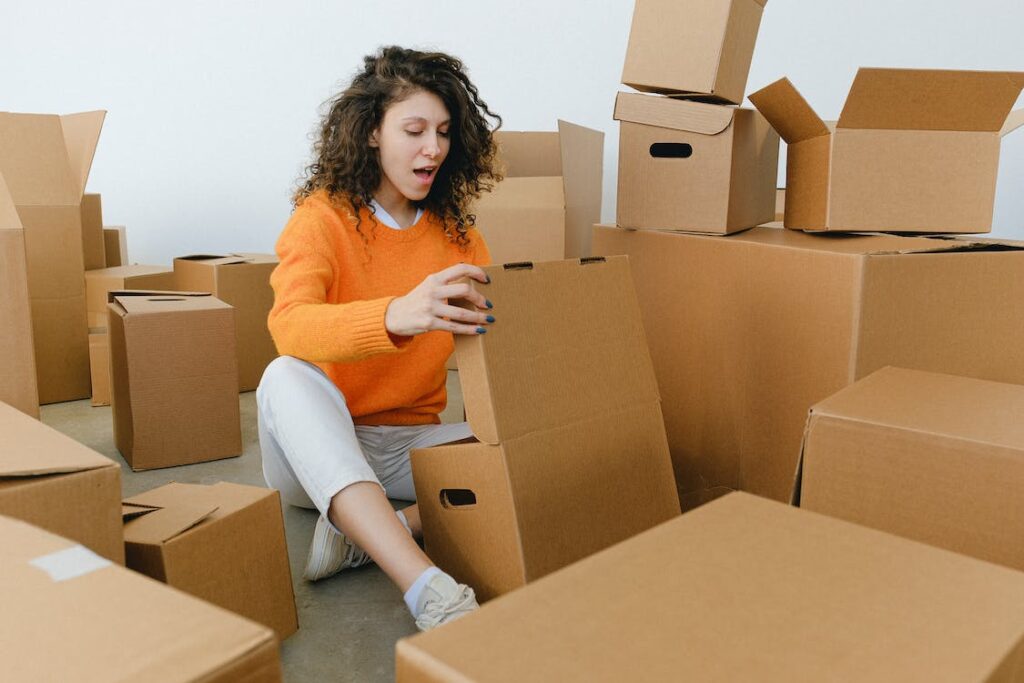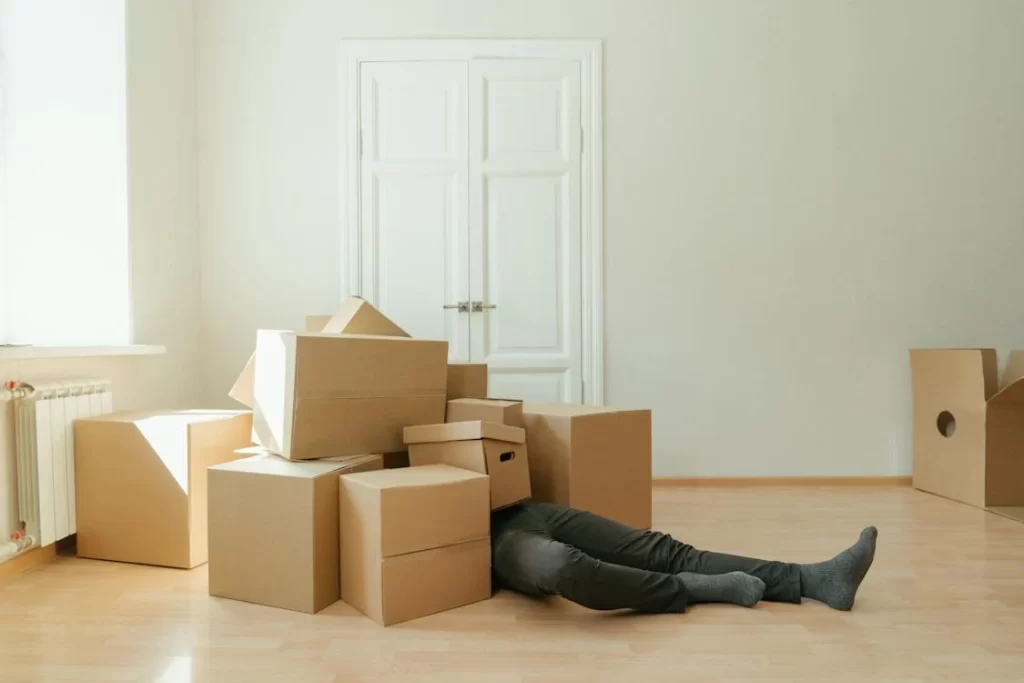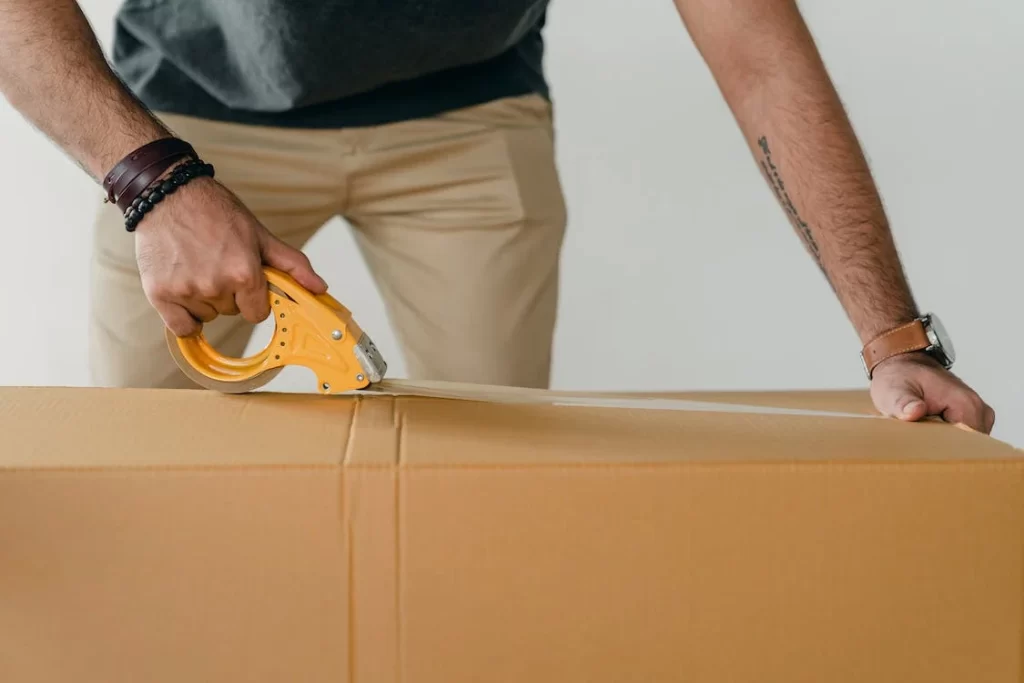Table of Contents
As awareness of environmental issues grows, more people are seeking ways to make their everyday activities more sustainable. Moving is no exception. Using eco-friendly packing materials is an important step toward a more sustainable moving process. By choosing sustainable moving supplies, you can significantly reduce your environmental impact and contribute to a healthier planet. This guide by Golden Bay Relocations provides essential green moving tips to help you select the best environmentally friendly packing materials for your next move.
Opting for biodegradable packaging options and recycled packing materials can make a significant difference in reducing waste and conserving natural resources. In this blog, we’ll explore the benefits of green packing materials, provide tips on choosing eco-friendly boxes, wraps, and labels, and offer practical advice on minimizing packaging waste. Let’s dive in and discover how you can make your next move more sustainable.

Benefits of Eco-Friendly Packing Materials
Using eco-friendly packing materials offers numerous environmental benefits. Here are some key advantages:
Reduction of Waste: Traditional packing materials, such as plastic bubble wrap and foam peanuts, contribute to landfill waste and take hundreds of years to decompose. In contrast, biodegradable packaging options break down much faster, reducing the amount of waste that ends up in landfills.
Lower Carbon Footprint: Producing traditional packing materials often requires significant energy and resources. Sustainable moving supplies, such as recycled cardboard and biodegradable wraps, generally have a lower carbon footprint because they use fewer resources and less energy to produce.
Conservation of Natural Resources: By choosing recycled packing materials, you help conserve natural resources like trees and petroleum. For example, using boxes made from recycled cardboard reduces the demand for virgin paper and helps preserve forests.
Minimization of Environmental Impact: Environmentally friendly packing materials are designed to have a minimal impact on the environment. They decompose more quickly and safely, reducing pollution and harm to wildlife.
By understanding and embracing these benefits, you can make more informed choices when selecting packing materials for your move. The next sections will provide detailed guidance on choosing and using these sustainable options.
Choosing Eco-Friendly Boxes
Selecting the right boxes is a crucial part of eco-friendly packing. Here are some options for eco-friendly packing materials when it comes to boxes:
Recycled Cardboard: Boxes made from recycled cardboard are a great choice. They are sturdy, widely available, and have a much lower environmental impact compared to boxes made from virgin materials. Look for boxes labeled as 100% recycled or made from post-consumer materials.
Biodegradable Cardboard: Another option is biodegradable cardboard boxes. These boxes are designed to break down more quickly than traditional cardboard, making them a more sustainable choice. They are just as durable as regular cardboard boxes and can be reused multiple times before being recycled or composted.
Reusable Plastic Bins: While not biodegradable, reusable plastic bins are a sustainable option because they can be used many times before they need to be recycled. These bins are durable, stackable, and often come with secure lids, making them ideal for moving.
When choosing boxes, consider their durability, size, and availability. Make sure they are strong enough to protect your belongings during the move and that they come in sizes that meet your packing needs. Additionally, check local availability or online retailers for recycled packing materials to ensure you can source them easily.
Biodegradable Wrapping Materials
Traditional bubble wrap and plastic packaging materials are notorious for their environmental impact. Fortunately, there are several biodegradable packaging options available that offer the same protective benefits without the negative effects on the environment.
Biodegradable Bubble Wrap: Made from biodegradable plastic, this type of bubble wrap offers the same cushioning as traditional bubble wrap but decomposes much faster. It’s an excellent choice for protecting fragile items.
Recycled Paper: Using recycled paper for wrapping and padding is a simple yet effective way to reduce plastic use. Recycled paper can be crumpled to provide cushioning or layered to protect delicate items. It’s fully recyclable and biodegradable, making it an eco-friendly choice.
Cornstarch-Based Packing Peanuts: Traditional packing peanuts are made from polystyrene, a type of plastic that doesn’t break down easily. Cornstarch-based packing peanuts are a sustainable alternative. They offer the same cushioning properties but dissolve in water and biodegrade quickly.
By opting for biodegradable wrapping materials, you can significantly reduce your plastic waste and contribute to a more sustainable moving process. These materials provide effective protection for your belongings while being kinder to the planet.
Recyclable Labels and Tape
Securing your boxes and identifying their contents are essential parts of the moving process. Fortunately, there are environmentally friendly packing materials available for labels and tape as well.
Recyclable Paper Labels: Traditional labels are often made from plastic or coated with non-recyclable materials. Recyclable paper labels, on the other hand, are made from sustainable materials and can be easily recycled along with your boxes. Look for labels that are made from recycled paper and have non-toxic adhesives.
Biodegradable Adhesive Tape: Traditional packing tape is usually made from plastic and is not biodegradable. Biodegradable adhesive tape is a greener option. Made from materials like cellulose or paper, this tape breaks down naturally and doesn’t leave harmful residues. It’s just as strong as traditional tape and can securely seal your boxes.
By choosing recyclable or compostable labels and tape, you can further reduce the environmental impact of your move. These alternatives are effective, easy to use, and much better for the planet.

DIY Eco-Friendly Packing Materials
In addition to purchasing eco-friendly packing materials, you can also get creative with DIY alternatives using household items. This approach not only reduces waste but also saves money.
Towels and Blankets: Use towels, blankets, and other linens to wrap and cushion your belongings. These items provide excellent protection and can be reused after the move.
Newspapers and Magazines: Old newspapers and magazines can be crumpled and used as padding. They are a great way to recycle paper and provide adequate cushioning for fragile items.
Clothing: Use clothing to wrap delicate items or fill empty spaces in boxes. This method reduces the need for additional packing materials and makes efficient use of space.
Repurposed Boxes: Instead of buying new boxes, look for ways to repurpose boxes you already have. For example, grocery stores often have sturdy boxes they are willing to give away. Reusing these boxes helps reduce waste and saves money.
By using these DIY eco-friendly packing materials, you can minimize your environmental impact and make your move more sustainable. These creative solutions are effective and help repurpose items you already have at home.
Where to Find Eco-Friendly Packing Materials
Finding eco-friendly packing materials is easier than you might think. Here are some sources for purchasing or obtaining these sustainable options:
Online Retailers: Websites like EcoEnclose, U-Haul, and Amazon offer a variety of sustainable moving supplies. These retailers provide detailed information about the materials used and their environmental benefits.
Specialty Stores: Many specialty stores focus on eco-friendly products. Stores like The Container Store and Staples often have sections dedicated to green packing supplies. Shopping at these stores allows you to see and feel the products before purchasing.
Local Businesses: Supporting local businesses can also be a great way to find eco-friendly packing materials. Many local moving companies, like Golden Bay Relocations, offer sustainable packing options. Additionally, local hardware stores and recycling centers may have eco-friendly supplies available.
Tips for Sourcing Locally: When sourcing sustainable packing materials locally, consider visiting farmers’ markets, craft fairs, and community events. These venues often feature vendors who specialize in eco-friendly products. Supporting these suppliers helps reduce the carbon footprint associated with shipping and promotes local economies.
By exploring these sources, you can find a wide range of eco-friendly packing materials that meet your needs and support sustainable moving practices.
Tips for Minimizing Packaging Waste
Reducing packaging waste is a key component of sustainable moving. Here are some green moving tips to help you minimize waste during your move:
Pack Efficiently: Maximize the use of space in your boxes by packing efficiently. Use smaller items to fill gaps and avoid overpacking or underpacking boxes. This reduces the number of boxes needed and minimizes waste.
Reuse Materials: Whenever possible, reuse packing materials from previous moves or shipments. Boxes, bubble wrap, and packing peanuts can often be reused multiple times before they need to be recycled.
Recycle Properly: After your move, make sure to recycle any packing materials that are no longer usable. Check local recycling guidelines to ensure that items like cardboard, paper, and biodegradable plastics are disposed of correctly.
Repurpose Packing Materials: Get creative and find ways to repurpose packing materials. For example, use old boxes for storage, or turn packing peanuts into craft projects. Repurposing materials extends their life and reduces waste.
Dispose Responsibly: If you have packing materials that cannot be reused or recycled, dispose of them responsibly. Look for disposal options that minimize environmental impact, such as composting biodegradable materials or taking hard-to-recycle items to specialized facilities.
By following these tips, you can minimize packaging waste and make your move more sustainable. These strategies help reduce your environmental footprint and promote responsible moving practices.

Educating Others About Green Packing
Spreading awareness about the benefits of eco-friendly packing materials and sustainable moving practices is important for encouraging wider adoption. Here are some ways to educate others and promote environmentally conscious choices:
Share Information: Share your knowledge about green moving tips and sustainable moving supplies with friends, family, and colleagues. Use social media, blog posts, and word of mouth to spread the word about the benefits of eco-friendly packing materials.
Lead by Example: Demonstrate your commitment to sustainable moving by using environmentally friendly packing materials in your own moves. When others see the positive impact of your choices, they may be inspired to follow suit.
Organize Workshops and Events: Host workshops or events focused on green packing and sustainable moving practices. Invite experts to speak about the environmental benefits and practical tips for using eco-friendly materials. These events can help build a community of environmentally conscious movers.
Collaborate with Local Organizations: Partner with local environmental organizations to promote green packing practices. Collaborate on campaigns, events, and educational materials that highlight the importance of using eco-friendly packing materials.
Provide Resources: Create and share resources, such as guides and checklists, that make it easy for others to adopt sustainable moving practices. Include information about where to find eco-friendly materials and how to minimize waste.
By educating others about green packing, you can help create a ripple effect that leads to more sustainable moving practices in your community. Encouraging others to make environmentally conscious choices contributes to a healthier planet for everyone.
Future Sustainability Practices
Sustainable moving doesn’t end once you’ve settled into your new home. Here are some ways to incorporate green moving tips and environmentally friendly packing materials into your everyday life:
Continued Use of Eco-Friendly Materials: Keep using eco-friendly materials in your daily activities. For example, use recycled paper for gift wrapping, choose biodegradable bags for shopping, and opt for reusable containers for storage.
Adopt Sustainable Habits: Incorporate sustainable habits into your routine. Reduce, reuse, and recycle whenever possible. Practice mindful consumption by choosing products with minimal packaging and supporting brands that prioritize sustainability.
Advocate for Sustainability: Continue to advocate for sustainable practices in your community. Support policies and initiatives that promote environmental conservation and responsible resource use. Engage in community efforts to reduce waste and protect natural habitats.
Educate and Inspire Others: Keep sharing your knowledge and experiences with others. Inspire friends, family, and colleagues to adopt green practices by showcasing the benefits of sustainability. Use your influence to encourage positive change.
Plan for Future Moves: If you plan to move again in the future, incorporate what you’ve learned about sustainable moving into your plans. Start early, source eco-friendly packing materials, and strive to make each move more sustainable than the last.
By incorporating these practices into your life, you can continue to support sustainability long after your move. Making environmentally conscious choices every day helps build a better future for generations to come.

Embrace Sustainable Moving with Golden Bay Relocations
Making the switch to eco-friendly packing materials is a significant step toward a more sustainable moving process. By following the tips and strategies outlined in this guide, you can reduce your environmental impact and promote a healthier planet.
From understanding the benefits of green packing materials to choosing the right boxes, wraps, and labels, each step contributes to a more sustainable move. By educating others and incorporating sustainable practices into your everyday life, you can continue to make a positive impact long after your move is complete.
If you’re planning a move, consider using Golden Bay Relocations for professional moving services. Our team is committed to sustainability and can help you make environmentally conscious choices throughout your move. Contact us today for a free quote and let us assist you in creating a greener, more sustainable moving experience.